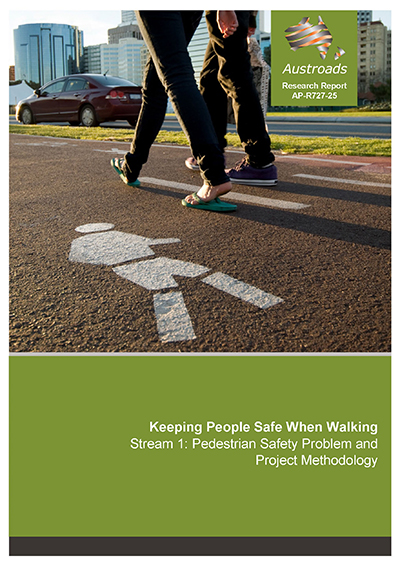Road Safety

- Publication no: AP-R727-25
- ISBN: 978-1-922994-67-7
- Published: 21 March 2025
- PDF (free) Download
This report establishes the foundational framework for Austroads’ Keeping People Safe When Walking – Stream 1 project. It defines key pedestrian safety concepts, highlights the magnitude and characteristics of pedestrian safety issues, and introduces the Pedestrian Safe System Model and the Pedestrian Safety Data Needs Framework. These frameworks are designed to guide evidence-based interventions and data improvements aimed at reducing pedestrian fatalities and serious injuries in Australia and New Zealand.
The report employs a comprehensive methodology that includes research and literature review, stakeholder engagement (focus groups, surveys, in-depth interviews, and technical workshops), and data analysis and modelling (including Vision Zero and trauma modelling). Through a multi-phase approach, the report systematically assesses pedestrian safety data needs and evaluates effective interventions. The findings lead to key recommendations, refined through stakeholder input, to support the goal of halving pedestrian serious trauma by 2030 and achieving zero fatalities and serious injuries by 2050.
This report is the first of the 4 reports produced as part of the project. The other 3 reports include:
- Keeping People Safe when Walking – Stream 1: Literature Review
- Keeping People Safe when Walking – Stream 1: Pedestrian Data Improvement Recommendations
- Keeping People Safe when Walking – Stream 1: Recommended Pedestrian Safety Interventions
Join us for a webinar on Thursday 17 April presented by Dr Hafez Alavi, Dr Shane Turner and Lewis Martin to learn more about this project.
There will be question and answer opportunities during the session. No charge but registration is essential. Can’t make the live session? Register and we’ll send you a link to the recording.
- Summary
- 1. Introduction
- 1.1 Purpose
- 1.2 Scope
- 1.3 Methodology
- 2. Pedestrian Safety Context
- 2.1 Scope of works and deliverables
- 3. Pedestrian Safety Vision, Foundational Concepts, Models and Frameworks
- 3.1 Project pedestrian safety vision and goal
- 3.2 Key pedestrian safety concepts
- 3.3 Pedestrian Safe System Model
- 3.4 Underlying road safety theoretical and practical framework
- 3.5 Current pedestrian safety assessment approaches/methods
- 3.6 Pedestrian Safety Data Needs Framework
- 3.7 Key processes to utilise and customise the Pedestrian Safety Data Needs Framework
- 4. Identified Pedestrian Safety Problems
- 4.1 Literature review
- 4.1.1 Factors associated with pedestrian involvement in crashes
- 4.1.2 Factors associated with pedestrian serious injuries
- 4.2 Online survey
- 4.3 Focus groups
- 4.4 Pedestrian data analysis (Vision Zero modelling and forecasting)
- 4.5 Pedestrian Trauma Modelling
- 4.6 In-depth interviews
- 4.7 Key pedestrian safety problems in Australia and New Zealand
- 5. Conclusions and Recommendations
- 5.1 Conclusions
- 5.2 Recommendations
- References
- Appendix A A Summary of Key Methods Utilised in Stream 1 Methodology
- A.1 Pedestrian Safe System Model and Pedestrian Safety Data Needs Framework
- A.1.1 Method and approach for developing the Pedestrian Safe System Model
- A.1.2 Method and approach for developing the Pedestrian Safety Data Needs Framework
- A.1.3 Integration of conceptual models and frameworks
- A.2 Stakeholder engagement strategy
- A.2.1 Introduction to the stakeholder engagement strategy
- A.2.2 Stakeholders identification and analysis
- A.2.3 Engagement strategies and activities
- A.3 Literature Review
- A.3.1 Purpose and context of the literature review
- A.3.2 Scope and research questions
- A.3.3 Methodology and execution
- A.4 Focus groups
- A.4.1 Background, and focus group composition and topics
- A.4.2 Methodology and findings
- A.5 Online survey
- A.5.1 Methodology and objectives of the online survey
- A.5.2 Survey participation and depth of responses
- A.5.3 Potential biases and integration of findings
- A.6 Pedestrian data analysis and forecasting
- A.6.1 Introduction and current state analysis
- A.6.2 Methodology: Backcasting approach
- A.6.3 Forecasting and cumulative FSI savings
- A.7 Pedestrian Trauma Modelling
- A.7.1 Summary and objectives of Pedestrian Trauma Modelling
- A.7.2 Method and data challenges
- A.8 Current state of pedestrian data and gap analysis
- A.8.1 Evaluation of current practices and identification of gaps
- A.8.2 Strategic recommendations for enhancement
- A.8.3 Feasibility, impact, and priority assessment
- A.9 Systems-based pedestrian safety intervention approach
- A.9.1 Foundational principles and approach
- A.9.2 Safe System pillars and Road Safety Management
- A.9.3 Implementation of systems-based pedestrian safety approach
- Appendix B The Road Trauma Chain Model
